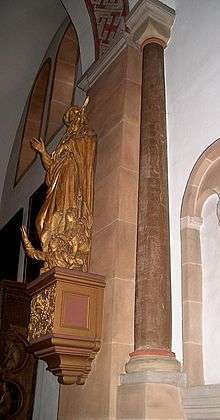Calcareous sinter
Calcareous sinter is a freshwater calcium carbonate deposit, also known as calc-sinter. Deposits are characterised by low porosity and well-developed lamination. Calcareous sinter should not be confused with siliceous sinter, which the term sinter more frequently refers to. It has been suggested that the term "sinter" should be restricted to siliceous spring deposits and be dropped for calcareous deposits entirely.
Features
Calcareous sinter is characterised by laminations of prismatic crystals growing perpendicular to the substrate; laminations are separated by thin layers of microcrystalline carbonate.[1] Macrophytes are absent, consequently porosity is very low. Exclusion of species is due either to high temperature (travertine), high pH/ionic strength (tufa) or absence of light (speleothems).
Pedley (1990)[2] suggests the term be abandoned in favour of tufa for ambient temperature deposits (and presumably travertine for geothermally heated deposits). This avoids any potential confusion with siliceous sinter and prevents deposits formed in different environmental conditions (hot spring deposits, cold spring deposits and speleothems are all lumped together under the term sinter) from being amalgamated into one group.
Geochemistry
Deposits are formed from either calcite or aragonite. Precipitation is brought about by degassing of CO2, which decreases the solubility of calcite/aragonite. (See tufa/geochemistry)
Notable deposits
- Pure calc sinter, typical for aqueducts and all kinds of water facilities.
 Roman aqueduct in Germania Inferior. Eifel Aqueduct, clogged by fine sinter.
Roman aqueduct in Germania Inferior. Eifel Aqueduct, clogged by fine sinter. Deposits of several thousand years of calc sinter (travertine) in the Bridgeport, California Hot Springs
Deposits of several thousand years of calc sinter (travertine) in the Bridgeport, California Hot Springs
Medieval extraction and use

The build-up of calc-sinter material in the Eifel Aqueduct was commercially exploited in the 11th and 12th centuries. With deposits up to 30 centimetres (12 in) thick, the material was cut into vertical columns of polished brown rock with impressive layered patterns, which made it much in demand by cathedral builders across large parts of central Europe and beyond.[3] In England it was used to provide polychromy, contrasting with the pale limestone favoured by Norman English Cathedrals. The stone was for many years known as 'Onyx Marble' despite being very obviously neither onyx nor marble. Those studying the stonework at Canterbury Cathedral were unaware of its origins in the aqueduct until 2011.[4] Such large-scale use as the cloisters around a cathedral quadrangle needed many hundreds of columns, which must have been supplied by a well-organised extraction and transport operation. The Eifel deposits, have also been identified at Rochester[5] and in the now lost Romanesque cloister at Norwich[6] as well as the Infirmary Cloister, Chapter House windows, Anselm Chapel door and the Treasury gateway at Canterbury.[7]
References
- Flügel, E. 2004. Microfacies of Carbonate Rocks. Germany: Spring-Verlag. ISBN 3-540-22016-X
- Pedley, H.M. 1990. Classification and environmental models of cool freshwater tufas. Sedimentary Geology 68, pp. 143-154.
- Tegethoff, F. Wolfgang; Rohleder, Johannes; Kroker, Evelyn. (2001). Calcium Carbonate: From the Cretaceous Period Into the 21st Century. Birkhäuser. ISBN 3-7643-6425-4.CS1 maint: multiple names: authors list (link)
- C. Wilson (2015). "Canterbury Cathedral's Mystery "Marble": A Double Imposture Unmasked'". In P. Fergusson (ed.). Canterbury Cathedral Priory in the Age of Becket. New Haven and London. pp. 156–60.
- John McNeill (2015). "The Romanesque Cloister in England". Journal of the British Archaeological Association. 168: 34–76. doi:10.1179/0068128815Z.00000000038.
- R.B. Harris (2019). "Reconstructing the Romanesque Cloister of Norwich Cathedral". The Antiquaries Journal. Cambridge University Press. 99: 133–159. doi:10.1017/S0003581519000118.
- Geoff Downer (2019). "calc-sinter or Onyx Marble". canterbury-archaeology.org.uk. Canterbury Historical & Archaeological Society (CHAS).